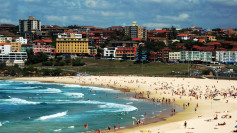North Korea is expanding a key missile production facility, raising concerns about its military collaboration with Russia amid the ongoing war in Ukraine. Satellite imagery analyzed by researchers at the James Martin Center for Nonproliferation Studies (CNS) has revealed significant construction at the February 11 plant, located within the Ryongsong Machine Complex in Hamhung, North Korea's second-largest city.
The facility is known for producing the KN-23 short-range ballistic missile, which Ukrainian officials have stated has been used by Russian forces in the conflict. Satellite images captured in early October by Planet Labs show construction of a new assembly building and housing facilities for workers, along with improvements to underground entrances at the complex.
"We see this as a suggestion that they're massively increasing, or they're trying to significantly increase, the throughput of this factory," said Sam Lair, a research associate at CNS, as reported by Reuters.
North Korea drastically expanding missile production.
Satellite images analyzed by U.S. researchers at the James Martin Center for Nonproliferation Studies, reveal that North Korea is expanding its "February 11" plant, the sole producer of Hwasong-11 missiles, reportedly used by… pic.twitter.com/mb4m6shlpS — SPRAVDI — Stratcom Centre (@StratcomCentre) November 25, 2024
The KN-23, referred to in North Korea as the Hwasong-11, is designed to evade air defenses by flying on a low, depressed trajectory. Its production at the February 11 plant appears to be ramping up, with the new assembly building estimated to be 60-70% the size of the existing one. Researchers believe this expansion signals an effort to enhance production capabilities.
Russia and North Korea signed a mutual defense treaty in June, further solidifying their military ties. Reports from U.S., South Korean, and Ukrainian officials indicate that more than 10,000 North Korean troops have been deployed to Russia's Kursk region, with some allegedly engaging in frontline combat. Deputy Pentagon press secretary Sabrina Singh stated on November 18 that it is likely that roughly 11,000 North Korean troops have entered Russia's Kursk region.
State-run KCNA recently reported that the Ryongsong Machine Complex is undergoing significant upgrades as part of a broader modernization effort. The news agency highlighted ongoing work to rebuild production facilities and install advanced machinery. SI Analytics, a South Korean satellite imagery firm, also identified new construction at the February 8 Vinalon Complex, which is believed to produce missile fuel.
The KN-23 missile was first tested in 2019 and is considered a significant technological advancement for North Korea's arsenal. Its ability to fly on a low trajectory makes it harder to intercept, a feature that may be useful for Russian forces in their attempts to counter Ukraine's air defenses.
In 2023, North Korean state media released images showing Kim Jong Un inspecting facilities at the Ryongsong Machine Complex, where workers were assembling components for what analysts identified as KN-23 missiles. These developments have fueled concerns about Pyongyang's growing role in supplying weapons to Russia.






